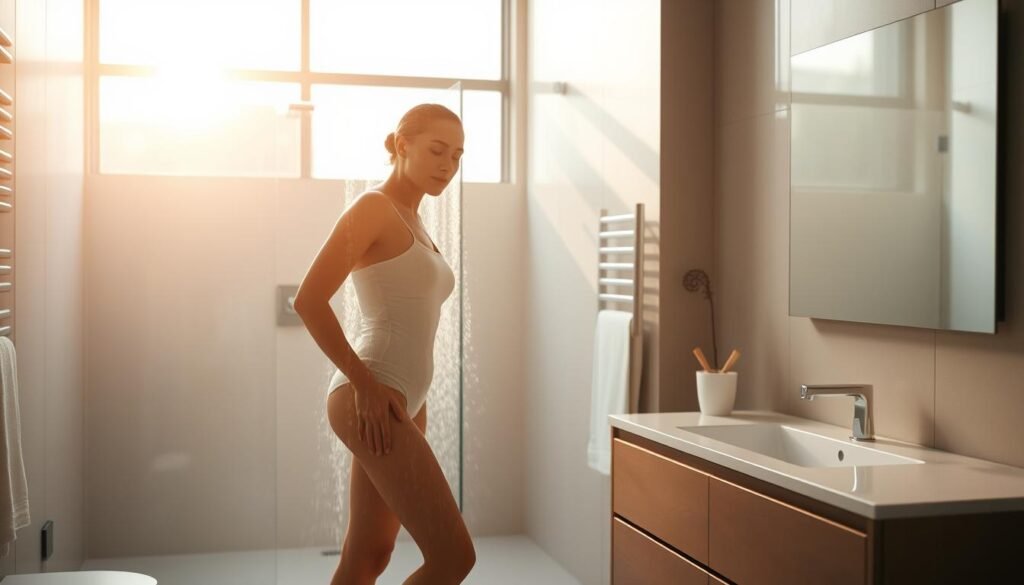Are you ready to try cold water therapy but don’t know how to start? Getting used to cold water can seem scary. But, with the right help, it can be safe and rewarding.
Cold water therapy, or cold shower therapy, has many benefits. It can improve your circulation and boost your energy. To start safely, you need to know the basics and get your body and mind ready.
Key Takeaways
- Understand the benefits and risks of cold water therapy
- Prepare your body and mind for the challenge
- Learn the basics of cold shower therapy
- Discover tips for a safe and effective cold water therapy practice
- Start your cold water therapy journey with confidence
Understanding Cold Water Therapy
Trying cold water therapy can change your body and mind. It involves taking cold showers to get health benefits. Knowing how it works and its benefits can help you see its value for better health.
Benefits of Cold Showers
Cold showers are good for your health. They improve blood flow, boost energy, and clear your mind. The sudden cold can release special chemicals that help with depression.
They also make your immune system stronger by releasing antioxidants. The cold shower benefits are not just physical. They also help your mental health. Many people feel more awake and focused after a cold shower.
How Cold Water Affects Your Body
Cold water shocks your skin, making your blood flow better and you more alert. This happens because of hormones and a stronger immune system. Cold water therapy can also lower inflammation, making you healthier.
| Physiological Response | Effect of Cold Water |
|---|---|
| Circulation | Increased circulation due to the body’s response to cold stress |
| Immune System | Boosted immune function through the release of antioxidants |
| Mental State | Enhanced mental clarity and reduced symptoms of depression |
Learning about cold water therapy benefits can make it a daily habit. The benefits of cold showers are many. This makes cold water therapy a great part of a healthy life.
Preparing for Cold Showers
To get the most from cold water therapy, you need to prepare mentally and physically. This prep helps you handle the shock of cold water better. It also makes the practice more beneficial for you.
Mental Preparation Techniques
Mental prep is key when starting a cold shower routine. Meditation and deep breathing exercises build mental toughness. They help you deal with the stress of cold water.
Setting clear goals for your cold shower practice is also helpful. Goals like improving mental clarity or boosting energy can keep you motivated.
Physical Preparations for Cold Exposure
Physically, start by gradually lowering the water temperature. This lets your body get used to the cold. It makes the first shock less intense.
Improving your health and fitness also helps. Regular exercise and a healthy diet make your body more resilient to cold. Always check with a doctor if you have health concerns.
Combining mental and physical prep makes cold showers safe and beneficial. This approach prepares you for the immediate effects of cold water. It also supports your long-term health and well-being goals.
Steps to Start Cold Showers Safely
Starting cold showers safely means taking it slow to get used to the cold. You need to prepare your mind and body for the cold. This makes the transition smoother and safer.
Gradual Temperature Adjustment
Start with warm water and slowly make it colder. This helps your body get used to the change. For example, you can start by ending your warm shower with cool water. Then, slowly make the cool water colder over time.
Recommended Duration for Beginners
Beginners should start with short cold showers and gradually get longer. Start with 30 seconds to 1 minute of cold water. As you get used to it, you can make it longer. Always listen to your body and don’t push too hard.
| Week | Cold Exposure Duration | Temperature Adjustment |
|---|---|---|
| 1 | 30 seconds | Cool water |
| 2-3 | 1 minute | Colder, but not icy |
| 4 and beyond | 2-3 minutes | Cold/Icy |
By following these steps and listening to your body, you can safely start cold showers. You’ll enjoy the benefits of cold therapy without the risks.
Common Myths About Cold Showers
Cold showers are gaining popularity, but myths still surround them. Many people hesitate to try cold water therapy because of safety and effectiveness doubts.
Debunking Popular Misconceptions
One myth is that cold showers are too harsh. But, when done right, they can be very refreshing and good for you. Cold water therapy benefits include better circulation, more energy, and clearer thinking.
Another myth is that cold showers are only for athletes or the very fit. But, cold shower benefits are for everyone, no matter your age or fitness level. Just start slowly and safely.

The Science Behind Cold Water Therapy
Cold water therapy boosts the body’s natural cold response. When you take a cold shower, your body works to keep your core warm. This can improve your immune system and help you lose fat.
The science shows that cold water therapy releases special chemicals in your brain. These chemicals, like noradrenaline, make you feel more awake and alert. Knowing this science helps you see the benefits and add it to your daily life.
In summary, cold showers are safe and effective when done right. By clearing up myths and understanding the science, you can make smart choices about using cold water therapy.
Safety Precautions Before Starting
It’s important to know the safety steps before starting cold water therapy. This is to avoid health problems. Cold water therapy is good for many, but not for everyone, especially those with certain health issues.
Identifying Health Conditions to Watch For
Some health conditions make cold water therapy risky. These include heart problems, Raynaud’s disease, and poor circulation. People with these should be careful or not try cold water therapy at all.
| Health Condition | Risk Level | Recommendation |
|---|---|---|
| Heart Problems | High | Consult a doctor before starting cold water therapy. |
| Raynaud’s Disease | High | Avoid cold water therapy or take extreme caution. |
| Poor Circulation | Moderate | Monitor your body’s response and adjust accordingly. |
When to Consult a Doctor
If you’re not sure about your health or have doubts about cold water therapy, see a doctor. They can give advice based on your health history and current condition.
Cold Shower Techniques for Beginners
Starting with the right approach is key for beginners in cold water therapy. This practice, also known as cold immersion therapy, involves exposing your body to cold water. It stimulates various physiological responses.

Starting with Warm Water
One effective cold shower technique for beginners is to begin with warm water. This step helps your body adjust to the shower without the shock of cold water. Gradually lowering the temperature helps your body adapt, making it easier to handle colder temperatures.
Start with a warm shower to feel comfortable. As you get used to it, you can slowly lower the temperature. This gradual change is a crucial part of a successful cold shower guide.
Incremental Cold Exposure
When you’re ready, introduce cold water gradually. Start by mixing cold water with warm water, increasing the cold water slowly. This incremental cold exposure is vital for cold immersion therapy. It helps your body get used to cold stress.
As you get more comfortable, your body will start to respond to cold stress. This includes better circulation and the release of neurotransmitters that boost alertness and energy.
By following these steps and adding cold showers to your daily routine, you can enjoy the benefits of cold water therapy. These include better mental clarity and a stronger immune system.
Maximizing the Benefits of Cold Showers
To get the most out of cold showers, take a complete approach. Mix cold water therapy with other activities. This way, you can boost its benefits and feel better overall.
Combining Cold Showers with Breathing Techniques
Adding breathing techniques to your cold shower routine can be very helpful. Deep breathing calms your nervous system. It makes the cold water feel less shocking and more enjoyable.
To do deep breathing in a cold shower, breathe slowly in through your nose and out through your mouth. This method helps your body adjust to the cold better.
Here are some breathing techniques you can try:
- Diaphragmatic Breathing: Focus on expanding your diaphragm instead of shallow chest breathing.
- Box Breathing: Breathe in for 4 counts, hold for 4, exhale for 4, and hold again for 4.
- Alternate Nostril Breathing: A yoga-inspired technique that balances your nervous system.
Post-Shower Recovery Tips
After a cold shower, your body needs to recover. Gentle stretching can help improve blood flow and ease muscle tightness. Also, meditation or progressive muscle relaxation can calm your mind and body.
Here are some tips for recovering after a cold shower:
| Recovery Technique | Benefits |
|---|---|
| Gentle Stretching | Improves circulation, reduces muscle tension |
| Meditation | Calms the mind, reduces stress |
| Progressive Muscle Relaxation | Relaxes muscles, reduces physical tension |
By using these techniques with your cold showers, you can make the most of cold water therapy. This will improve your health and well-being.
Cold Water Therapy vs. Other Methods
Cold water therapy has become popular, but it’s good to look at other hydrotherapy options. Cold water therapy, or cold immersion therapy, has many benefits. But how does it stack up against other hydrotherapy methods?
Cold water therapy involves using cold water, like in showers or baths, to trigger body responses. Other methods, like hot showers and cold baths, also affect the body in different ways.
Comparison with Hot Showers
Hot showers are great for relaxing and easing muscle tension. But they’re different from cold water therapy in how they affect the body. Cold water therapy releases neurotransmitters that boost alertness and energy. Hot showers, however, help you relax and can improve sleep.
- Cold water therapy can improve circulation and boost the immune system.
- Hot showers can help with muscle relaxation and improve sleep quality.
Choosing between cold water therapy and hot showers depends on what you want and your health goals. Some people find alternating between hot and cold water, or contrast showers, very beneficial.
Cold Baths vs. Cold Showers
Cold baths and cold showers are both part of cold immersion therapy. They share some benefits, but there are key differences.
- Cold baths involve fully immersing in cold water, which can be more intense than cold showers.
- Cold showers, on the other hand, gradually expose you to cold water, which can be less intense but still effective.
Cold plunge baths can reduce inflammation and improve mental clarity. But cold showers are more convenient and easier to do daily.
In conclusion, cold water therapy, whether through showers or baths, offers many benefits. Understanding how it compares to other hydrotherapy methods helps people make better choices for their health and wellness.
Creating a Cold Shower Routine
Starting a cold shower routine is key to making it a daily habit. A good routine boosts your circulation and energy. It’s all about consistency.
First, figure out how often and when you’ll take cold showers. It depends on your goals and comfort. Some like daily showers, while others start with a few times a week.
Frequency and Timing Recommendations
Beginners should start with 2-3 times a week. This lets your body get used to the cold. As you get more comfortable, you can shower more often.
The best time for a cold shower is in the morning. It wakes you up. Some also shower cold after working out to recover faster.
- Start with a manageable frequency and gradually increase it.
- Experiment with different timings to find what works best for your schedule and body.
- Consider taking a cold shower at the same time every day to make it a habit.
Tracking Your Progress
Keeping track of your progress is crucial. Use a journal or app to log your experiences. Note any changes in energy, mood, or health.
Tips for Effective Tracking:
- Record the temperature of the water and the duration of the shower.
- Note any physical or mental changes after the shower.
- Adjust your routine based on your observations to optimize the benefits.
Consistency is key in your cold shower routine. Listen to your body and adjust as needed. Over time, you’ll find a rhythm that makes cold showers a rewarding part of your day.
Sharing Your Cold Shower Experience
When you start taking cold showers every day, telling others about it can really help. It keeps you motivated and inspired. You can talk about how cold showers have boosted your energy and sharpened your mind.
Connecting with Like-Minded Individuals
Finding people who also enjoy cold water therapy is great. They offer support and encouragement. Together, you can face any challenges and celebrate your successes.
Encouraging Others to Take the Plunge
Sharing your story can also inspire others to try cold showers. You can share the good things you’ve noticed. This way, you help spread the word about cold water therapy’s benefits.



